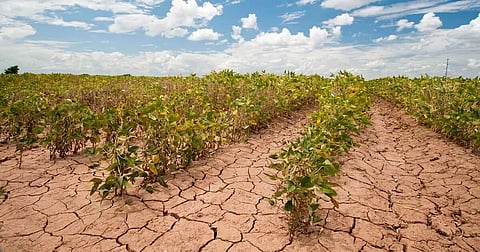
- Home
- Live Blog
- Breaking News
- Top Headlines
- Cities
- NE News
- Sentinel Media
- Sports
- Education
- Jobs

Rajbir Saha
(rajbirsaha1995@gmail.com)
Agriculture is the most vulnerable sector to climate change, owing to its huge size and sensitivity to weather parameters, thereby causing huge economic impacts. The changes in climatic events such as temperature and rainfall significantly affect the yield of crops. The effect of rising temperatures, precipitation variation, and CO2 fertilization varies according to the crop, location, and magnitude of change in the parameters. The temperature increase is found to reduce the yield, while the precipitation increase is likely to offset or reduce the impact of increasing temperature. As influenced by climatic variables when witnessed in Iran, crop productivity depends on adaptation abilities and crop type, climate scenario, and CO2 fertilization effect. The net revenue of farmers is found to decrease significantly with a decrease in precipitation or an increase in temperature in Cameroon. This factor and poor policy-making have led to low demand for Cameroon's agricultural exports, thereby causing fluctuations in national income. Statistical evidence shows the temperature affects coffee yield in Veracruz, Mexico. It was also found that coffee production may not remain economically viable for the producers in the coming years, as there is an indication of a 34% reduction in current production. The effect of climate change on crop yields vary according to the area and irrigation application. Crop yields can be increased by expanding irrigated areas, which can have a detrimental effect on the environment. The rise in temperature is likely to reduce the yield of many crops by reducing their duration. The aggregate production of wheat, rice, and maize are expected to decrease if both the temperate and tropical regions experience warming of 2 ?C. Climate change, in general, has more impact on tropical regions, as tropical crops remain closer to their high-temperature optima, and thereby experience high-temperature stress during elevated levels of temperature.
Moreover, insect pests and diseases are more prevalent in humid and warmer regions. Other parameters such as humidity and wind speed, along with temperature and rainfall, also impact crop yields, and in the absence of these parameters, there has been a chance of over-prediction of the cost of climate change. There has been a projection of higher droughts in the near future due to climate change in most of the regions of the world, and an increase of drought-affected areas from 15.4 to 44.0% is projected by 2100. Africa is cited as the most vulnerable area.
The yield of major crops in drought areas is expected to be reduced by more than 50% by 2050 and by almost 90% by 2100. The loss of crop yields can increase food prices and can have an absurd effect on agriculture welfare globally, with a 0.3% annual loss of future GDP globally by 2100.
However, it is found that climate change has limited influence on the world food supply, but the developing countries will face severe negative consequences. In India, the temperature is predicted to rise between 2.33 ?C and 4.78 ?C along with a doubling of CO2 concentration and longevity of heat waves, which could have a detrimental effect on the agriculture sector. In the arid region of Rawalpindi, Pakistan, an annual loss of INR 4180/acre is to be borne by farmers by 2100 with a 1 ?C increase in temperature, while the net revenue can be increased by INR 377.4 and INR 649.21 with an increase in rainfall of 8% and 14%, respectively. The yield losses in three cereal grains (rice, maize, and wheat) are projected to worsen by 10 to 25% with a 1 ?C increase in mean surface temperature globally. With a rising CO2 level in the atmosphere, the harvestable produce of crops is expected to increase, and the developmental changes in plants depend upon the type of crops.
But these beneficial impacts of raised CO2 are likely to be offset by elevated temperatures and altered precipitations. However, a positive impact of climate change on agriculture production is also observed in some areas. But these regional changes, whether increases or decreases, would not result in massive changes, and these changes will be more prominent in some low latitudes only. However, if the temperature is increased beyond that equivalent to doubled CO2, this can cause substantial economic losses. The detrimental impact of climate change will be enormous in developing countries' tropical regions, but it will largely depend on the region's climate scenario.
The pace of climate change determines its impact, thereby determining the cost of adjustment, so environmental policies must be dynamic and implemented with adaptation and flexibility. An increasing population has put a lot of pressure on agriculture to ensure the food and nutritional security of the world, which is further worsening with climate change.
A number of mitigation and adaptation strategies have been developed to offset the deleterious impact of climate change on agricultural sustainability. These technologies include water-smart practices (laser land levelling, rainwater harvesting, micro-irrigation, crop diversification, raised-bed planting, direct-seeded rice), nutrient-smart practices (precision nutrient application, leaf colour charts, crop residue management), weather-smart activities (stress-tolerant varieties, ICT[1]based agro-meteorological services), carbon-smart activities (zero tillage, legumes, crop residue management) and knowledge-smart activities (agricultural extensions to enhance capacity-building). These technologies significantly reduce the effects of climate change on crops and make them more suited to the climate by minimizing the unfavourable impacts.